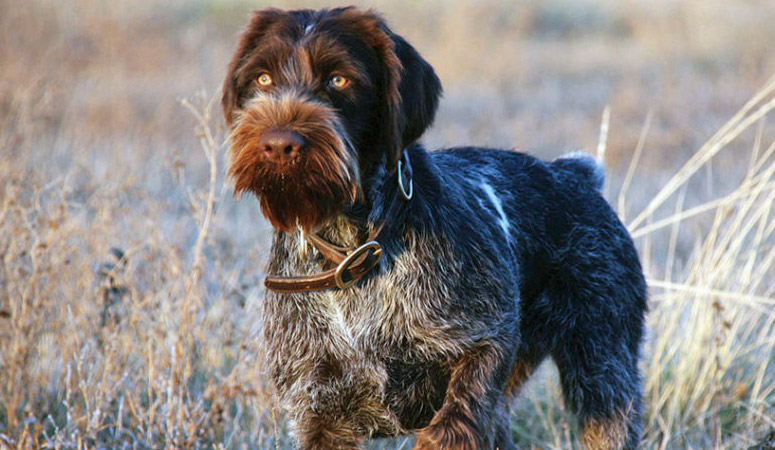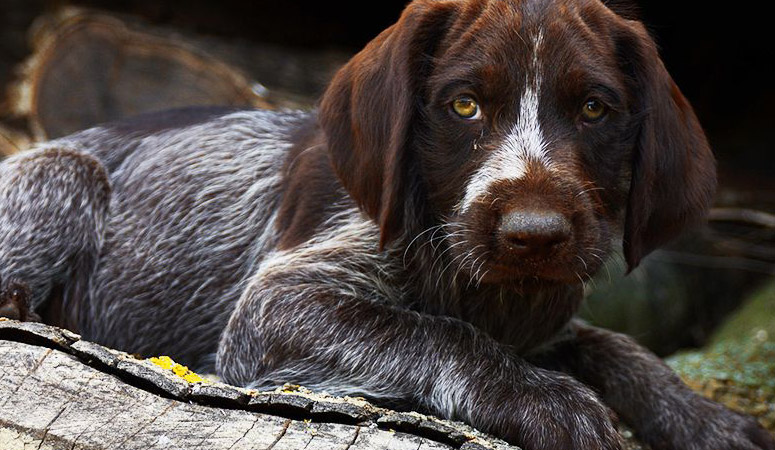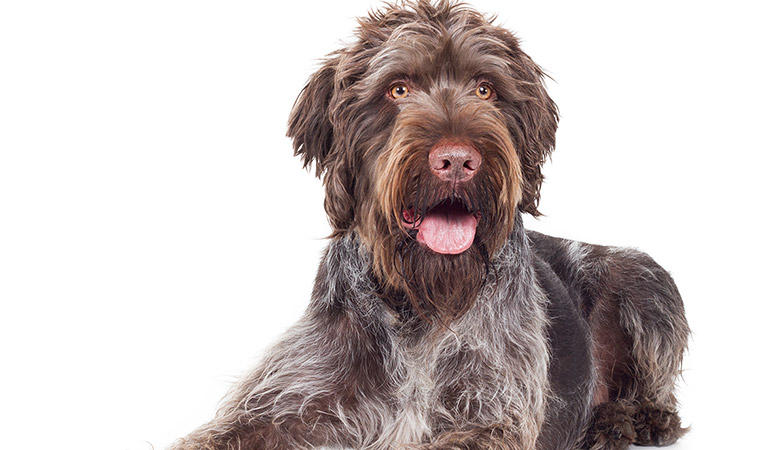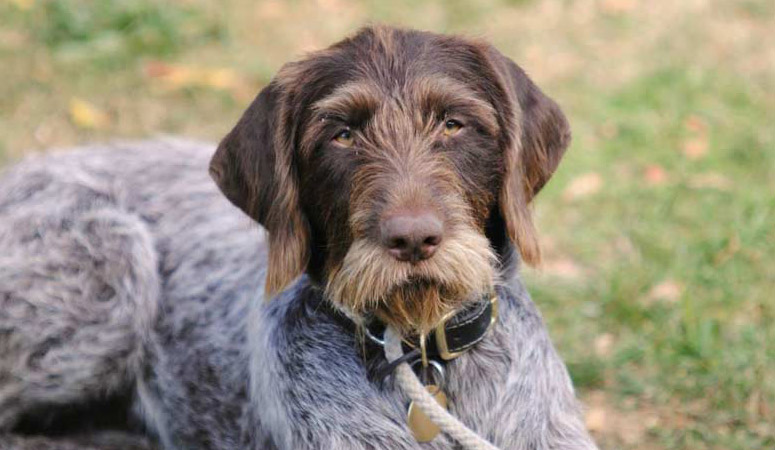German Wirehaired Pointer
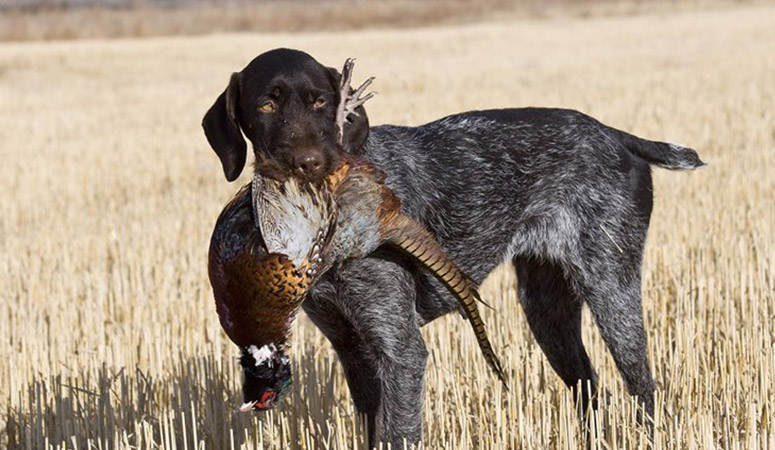
The German Wirehaired Pointer has a sturdy build and wiry hair that can help him hunt and retrieve, and suit for different terrain and hunting style. This breed is friendly and loves to spend time with their family, and they are great companions who are loyal and eager to please.
| Other Names | Deutsche Drahthaar, Deutscher DrahthaarIGer Vorstehhund |
| Color | Liver, Liver & White, Black & White |
| Height | Males: 21-24 inches. Females: 19-22 inches. |
| Weight | Males: 50-60 pounds. Females: 45-55 pounds. |
| Life Span | 14-16 years |
| Personality | Affectionate, Eager, Enthusiastic |
| Exercise | Needs Lots of Activity |
| Origin |
| Popularity | #63 |
| Groom Needs | Weekly |
| Kids Friendly | Yes with supervision |
| Dog Friendly | Yes with supervision |
| Watch Dog | |
| Family Dog | |
| Litter Size | 6-10 |
German Wirehaired Pointer Pictures
German Wirehaired Pointer Video
Introduction
Placed under the Sporting group of dogs by the American Kennel Club, the German Wirehaired Pointer is an optimistic dog with a free spirit, as though to satisfy a constant urge to break into a run. They are independent and willed, good attributes for a breed that was once a renowned hunting dog. They come in a harsh wired coat which protects them from the harsh conditions of the elements, as they are versatile gun dogs, built to work in all terrains and weather conditions.
They are well-muscled and balanced dogs with a sturdy build. Coat colors are liver or black, both with white markings and some solid patches, especially around the chest. The German Wirehaired Pointer (GWP) is a medium-sized dog, the male of which stands to a shoulder height of 24-26 inches, and 22 inches or more for a full-grown female. They weigh around 55-70 pounds and have an average lifespan of 13-16 years.
Living with German Wirehaired Pointer
The German Wirehaired Pointer has a dense, wiry coat that needs minimal grooming. Their distinct double coat shed twice a year, weekly brushing with a comb and soft slicker brush could help remove dirt and loose hair and keep the dog looking his best. Also, the owners need to comb your dog’s beard and mustache daily to remove food or dirt. Bath your German Wirehaired Pointer as needed, and he can dry quickly after a bath or swim as their coat is water-repellent.
Besides, brush your dog’s teeth at least two or three times a week to remove tartar buildup and the bacteria that lurk inside it, and the daily brush is better to keep fresh breath and prevent gum disease. Check the ears regularly and clean with gentle cleanser and solution. Trim the nails regularly to keep them in good condition and prevent toenail injuries.
As German Wirehaired Pointers are high-energy sporting dogs, they like outdoor activities with human partners and make great companions on long walks and hikes. Daily short walk is not enough for a healthy German Wirehaired Pointer, he needs several hours vigorous exercise every day, which can be swimming, long walking, and retrieving. If possible, a mix of activities, such as running, agility training, and field training are better. The German Wirehaired Pointer can suit to outdoor activities and fit well with a sporty family.
Generally, it is recommended to feed a German Wirehaired Pointer with two and a half to three cups high-quality dry dog food per day. There should be clean fresh water at all times. More importantly, the food amount should vary depending on your dog’s weight, activity level, and age.
Some dogs are easy to get overweight, so you need to watch their calorie consumption and weight level all the time. Treats may be an important aid in training, but excessive intake can lead to obesity. Also, owners need to distinguish which human food is safe for dogs and which are not. If you have any problems with your dog’s weight or diet, just consult from your veterinarian.
German Wirehaired Pointers are prone to the following health conditions: Canine hip and elbow dysplasia, Heart disease, Seizures, Gastric torsion, ear infections, skin cancer…
Major concerns: CHD
Minor concerns: hypothyroidism
Occasionally seen: elbow dysplasia, seizures, gastric torsion, entropion, vWD, heart disease
Suggested tests:
Cardiac Exam
Hip Evaluation
Thyroid Evaluation
Elbow Evaluation
Ophthalmologist Evaluation
Total Annual Cost: $2889
Cost is estimated for the first year and may vary depending on many factors, such as dog food, health care, leash, collar, licensing, possible fencing, crates, training and obedience classes, dog-walking, grooming, treats, toys, flea, tick, and heart-worm meds, microchips, etc.
German Wirehaired Pointers are easy to train as they are very intelligent, responsive, and eager to please. But they are independent-minded and may not pay attention to housetraining or basic obedience lessons. Owners need to be patient and with positive reinforcement when training your dog. Besides, it is recommended to start early socialization and puppy training classes to confirm that your dog grows into a well-adjusted, well-mannered companion.
Owners need to mention that German Wirehair Dogs crave human companionship, if they are always left alone for a long time period they may become destructive and change to undesirable behaviors.
Furthermore, German Wirehaired Pointers can excel in some canine sports, such as agility training, dock diving, flyball, and most other dog sports. And they can perform well in field trials, upland hunting, and waterfowl hunting.
History
The name German Wirehaired Pointer is a direct translation of the German name for the dog, Deutsch-Drahthaar. They were first developed in Germany around early 1800s, when German breeders had a frenzy to create a versatile breed of gun dogs which could engage in pointing in uplands and in the waters, serve as a retriever for waterfowls and yet possess adaptable features to enable it to travel the mountainous Alps, the flatlands of the farmstead and the thick forests. Although at that time in England, breeders preferred to breed separate dogs for different purposes, other European countries had begun to revolutionize the sport dog industry, so to speak.
Baron Sigismund von Zedlitz und Neukirch, a popular German breeder at the time was believed to have been instrumental to the development of the German Wirehaired Pointer (GWP) breed. Although it isn’t clear which breeds specifically went into the lineage of this dog breed, it is agreed by some experts that the Pudelpointer, Stichelhaar, Wirehaired Pointing Griffon, and Deutscher-Kurzhaar were probably ancestors of the GWP.
By the mid 19th century, when the classification of dogs was based on breed and not merely type, these dogs were later distinctly recognized as the German Wirehaired Pointer. Today, the German Wirehaired Pointer is a well-recognized breed in most countries of the world. However, North American breeders only began to import this breed around the 1920s and, in 1959, the American Kennel Club registered its first German Wirehaired Pointer. The German Wirehaired Pointer Club of America was founded in 1959 and the breed is ranked 63rd most popular dog breed in the U.S by the American Kennel Club.
Helpful Information
Breed Club: GERMAN WIREHAIRED POINTER CLUB OF AMERICA, INC.
Breed Club Link: https://gwpca.com/
Breed Club Rescue: National GWP Rescue, Inc
Breed Club Rescue Link: http://www.nationalgwprescue.com/

